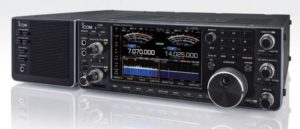
- “The flexibility of this new technology is just amazing. When you purchased a radio in the past what you got was locked in. With the new technology the manufacturers can easily add changes and updates that can be downloaded to the radio to both correct and add new features. The IC 7610 is just a pleasure to operate and I can’t say enough about DX Engineering and their staff.”
- “By far the best receiver I have ever owned or listened to on SSB or CW. The Digi Select and APF in CW will pull the weak ones out of the hash on the low bands.”
- “Worked 15 Euros the past two nights on 160 CW. Can’t work ‘em if you can’t hear ‘em, and the 7610 sure hears ’em. Kudos to Icom for the great RCVR.”
- “Replacing my 8 year old IC-7600 and [the IC-7610 is a significant upgrade. Last night on 160m I had an S-6 background noise level on the qtr wave INV-L. Switched to my SAL-30 rx antenna and noise fell to an amazing S-0….yes, ZERO, while working SM5EDX 599 both ways.”
- “I am extremely impressed so far with the 7610. It combines the best of the 7300, 7600 and 7800. That is the best brief summary I can give at this point of my ownership. The screen size and resolution are excellent without using an external monitor and my eyes aren’t young. The 7610 is exceptional (I don’t use that term lightly) for identifying on the scope, digging out and peaking weak CW signals, and that is a huge plus given we are descending quickly toward the bottom of Cycle 24.”
- “It has been flawless in its operation after being used or “on” about ten hours a day … all modes but mostly CW and Digital. It is hands down the most enjoyable CW rig I have used since I parted with my Ten-Tec Corsair.”
- “The 7610 is a 7300 on steroids.”
- “Been 18 years with my IC-756Pro. Glad I upgraded. Radio is easy to use. RX and TX reports have been outstanding.”
- “This is an amazing transceiver. The rig is easy to use and the noise reduction is great.
- My 7610 replaces my 7600 and has been in operation for ten days. So far it has met or exceeded my overall expectations.”
- “Love the low noise level and the noise reduction system.”
- “The performance of the IC-7610 compares favorably with that of the IC-7851. It’s equal in sensitivity and in some cases handles noise better than the IC-7851 does.”
- “I have been accused of being an Icom “fan-boy” because I have many. I was totally amazed by my 7300 and the 7610 is even better. Just an amazing radio.”
- “I enjoy the ability to do PSK31 or RTTY without having to tote my laptop everywhere I go. My IC-7300 was a treat to use but now comes along the IC-7610, this thing has ears! I’m hearing things I could only imagine before.”
To start deconstructing ‘the elephant’, the front-end filtering on each IC-7610 receiver is superior to the IC-7300, with better bandpass filtering and the one-pole Digi-Sel preselector module, which greatly improves the out-of-band rejection of big signals that can cause annoying intermodulation. If you are like me and have a powerful medium wave broadcast station relatively nearby, this is a really important feature.
When it comes to working DX, particular the major ‘once every 20 years’ DXpeditions such as the recent, sadly-aborted 3Y0Z operation, having two equally good receivers is priceless, because these expeditions will generally use up to a 5 to 10kHz ‘split’ between their transmit and receive frequencies. In the IC-7300, with its single receiver and dual VFOs, you can toggle back and forward between the receive and transmit frequencies but this is nothing like being able to listen to both frequencies simultaneously, by having one receiver in each ear of your headphones, as you can on the IC-7610.
All of my transceivers for the last 20 years have had dual receivers for this reason and there is no way I’d go back to a single receiver. Dual receivers enable you to know exactly what is happening in the pile-up and on the transmit frequency.
The next point to make is that instead of getting the 14-bit version of the popular LTC2208 analogue-to-digital converter (ADC) that lies at the heart of the IC-7300, it looks like getting the 16-bit version [2] in each of the IC-7610 receivers ‒ more of this later. 16-bit ADCs are used in the vast majority of high-end computer-assisted digital sampling SDRs, such as Apache Labs ANAN series [3] and Flex-Radio’s 6000 series [4] and the LTC2208 was originally used in the ground-breaking HPSDR [5].
For those like myself who are keen CW operators or who dislike clicking transmit-receive (TR) relays such as used in the IC-7300, the IC-7610 has solid-state, totally quiet, TR switching.
On the IC-7610, the CW keying waveform generation and shaping is carried out in the radio’s RF Field Programmable Gate Array (FPGA) to minimise any latency (the delay between Morse characters being formed by a key/keyer and then actually transmitted).
Unlike the IC-7300, the IC-7610 comes with superb audio peak filtering, adjustable in frequency, width and gain and available on both receivers, which is better than any analogue or digital audio filter that VK6VZ has ever used. This includes the excellent, well-regarded ones on the Elecraft K3, Ten-Tec Orion 2 and Yaesu FT-1000. The IC-7610 filter does an amazing job of cleaning up any CW or digital signal – not just in helping to dig weak ones out of the noise.
The high definition touch screen (7in diagonal) is substantially larger and easier to use than the one on the IC-7300 (4.3in) and you have the additional ability to use an external VGA monitor by plugging a cheap DVD-I to HDMI socket adapter (typically around £5) into the IC-7610, which in turn plugs into a HDMI to VGA converter (usually around £20) into which the screen is plugged, giving you a massive view of the IC-7610 spectrum scope and transceiver functions.
While it is possible to give the IC-7300 an external display by plugging it into a personal computer running the N1MM logging software [6], as most IC-7300 users will know, you cannot simply plug a monitor screen into it.
Other advantages of the IC-7610 over the IC-7300 are its larger physical size, which results in a much more comfortable, spacious and easy to use front panel. It is great, for example, to have a large Independent Receiver Tune control directly adjacent to the main tuning knob. The rear panel offers much better connectivity than the IC-7300, particularly where antennas concerned – you get two PL-259 antenna ports, plus a BNC-format receive antenna input and output, which can be switched between the two receivers.

